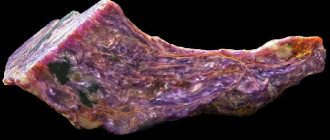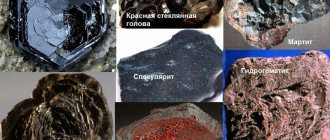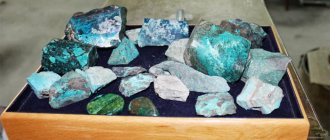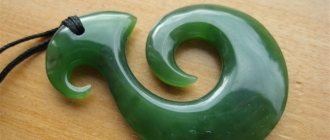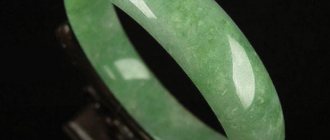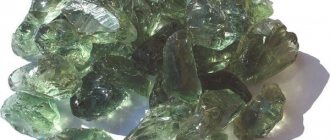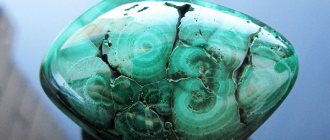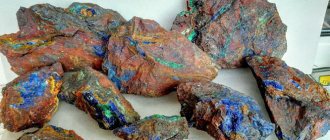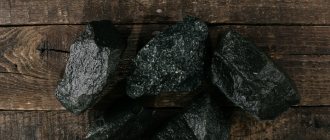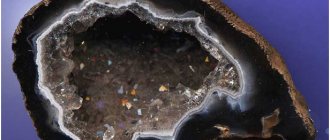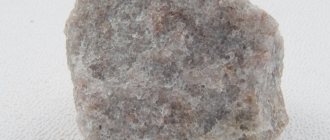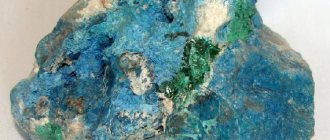Historical reference
The mineral was first discovered during a geological survey in 1948 by Soviet geologist V.G. Ditmar, who mistakenly called it cummingtonite shale.
The first charoite jewelry was made in 1973. Charoite was officially registered as a new mineral by V.P. Rogova in 1977.
While scientists were comprehensively studying the new mineral, jewelers had already begun to process and sell the ornamental stone. Soon the gem became so famous that many products made from it began to be sent abroad.
One of the American scientists studied imported Soviet charoite in his homeland and submitted an application to the International Commission on New Minerals to secure priority for the discovery. Irkutsk researcher Vera Parfentyevna Rogova sent her Application a little earlier, but her Application was not accepted and she was asked to change the name of the stone.
The name “charaite” initially proposed by the Irkutsk woman, according to the commission, turned out to be consonant with the name of another mineral - cheralite, which is why V.P. Rogova’s proposal was rejected. But justice triumphed. All members of the commission, except one, were in favor of awarding the honor of discovery to Vera Rogova. An American mineralogist wrote a letter of congratulations to his Siberian colleague.
Charoite still holds a lot of mysteries. The stone is so difficult to study that its first researcher, candidate of geological and mineralogical sciences Evgeniy Vorobyov, could not determine the exact formula for several years. Geologists do not yet have a consensus on the origin of charoite. Various versions were put forward by E.I. Vorobyov, N.V. Vladykin, M.D. Evdokimov, V.M. Biryukov and N.V. Berdnikov.
History of finds and definitions of charoite
The story of the discovery of an amazing mineral is worth knowing. After all, the enchanting stone can only be found in one place on the planet. This place is the Murun alkaline massif, the Lilac Stone deposit.
When exploring the massif in 1948, geologists initially mistook charoite for cummingtonite. After 20 years, a new generation of geologists arrived, among them the young Rogovs. Their names are inextricably linked with the mysterious mineral. They were looking for uranium, but a good geologist always describes rock outcrops, outcrops, and collects rock samples.
Honey-yellow tinaxite was first discovered in a small area (about 10 km2). Then Charoite (then unnamed) appeared on the scene. We looked for analogues in the world of minerals and studied stone.
It took 15 years, and only in 1977 was charoite recognized as having the right to be called a new mineral and have its own name. One should not be surprised by such a long “analysis” of the mineral; just look at its formula... And at least five versions about the origin of the stone have so far been put forward.
The Americans gave in
Scientists tried to unravel the amazing mineral, and meanwhile charoite had already begun to be inserted into jewelry. The beauty of the gem was quickly appreciated not only in Russia, but also abroad.
The smart American mineralogist submitted an application to the International Commission on New Minerals to secure the discovery.
The discoverer of the mineral, Vera Rogova, submitted a similar application even earlier. But she was not accepted, having found fault with the name that Vera asked to be given. The commission decided that "Charayit" was too similar to "Cheralit".
But the commission also included honest people who knew the history of the discovery of the mineral. Therefore, the American was refused, and the honor of discovering charoite (rightfully) was given to V. Rogova.
A mineralogist from behind the Iron Curtain sent congratulations to a Soviet geologist. She could not answer him - such were the times...
Don't boast
The Mineralogical Museum at the Louvre claims to have a complete collection of the Earth's minerals and can identify any stone.
The discoverer of charoite, Yu. Rogov, while at the museum, showed the staff a sample of charoite and asked to identify it. The stunned workers admitted that this was not in their collection and tearfully begged to sell the copy.
We recommend: RED JASPER - a stone of life, protection and health
Of course, the geologist refused.
Deposits and production
Polished charoite ore in the Museum of Geology of the SB RAS
All the most valuable samples of stone are found on the territory of the Republic of Yakutia, the government of which, in turn, sets a limit on the extraction of rare gems - no more than a hundred tons per year, but the actual production volumes are much less.
The only industrial deposit was discovered in 1960 by graduates of the Irkutsk Polytechnic Institute Yu.G. and V.P. Rogov (Murun massif). It is located on the border of the Irkutsk region and Yakutia in the Baikal Rift fault on the watershed of the Chara River and the Tokko River, and was named Lilac Stone after the color of the charoite. Development of the deposit began in the early 1970s, at which time the stone became known throughout the world.
The Murun massif, where the only charoite deposit on planet Earth is located, is a unique place. Many generations of geologists have defended their dissertations on this mountain system and the rare rocks with unique properties found there. Many of the stones mined here are found only in two or three regions of the planet. But charoite was no longer found anywhere else, even in the form of inclusions in other rocks.
There is practically no mining of charoite in the Irkutsk region today. In the 1990s, an American company bought the rights to develop the deposit, organized production, processing and export of semi-finished products by plane outside the Russian Federation.
Yakut pseudoshale
The history of this stone is inextricably linked with the name of V.G. Ditmar, an outstanding Soviet geologist who explored the Murun massif in the Republic of Yakutia, where the scientist discovered blocks of a mineral hitherto unknown to science, which he described in detail in his notes, at first mistaking it for a type of slate. Later, the geological base near which charoite was discovered was called Ditmarovskaya.
In 1960, after a detailed examination of the discovered rock, the exclusive purple mineral received its name, derived from the name of the local Chara river. The discoverers of industrial stone deposits were a group of geologists led by Alekseeva and Rogov.
Charoite belongs to the group of pyroxenes, and the rock in which it is contained is called charoitite. Sometimes it also contains inclusions of other minerals, 40 of which are extremely rare.
The Murun mountain range at the junction of Yakutia and the Irkutsk region has been studied by a huge number of geologists at different times. This amazing place produces a large number of gems that are not represented anywhere else in the world. Including charoite. The area of the territory where its deposits were found is only 10 square kilometers. The total number of mining points is 26. Stone reserves are estimated at 140 million tons. Local authorities set a quota for the extraction of the mineral - no more than 100 tons can be mined per year, although in reality even less is mined.
Varieties of charoite
The charoite stone, although rare, has been well studied, and its subspecies have been successfully classified. The pattern of the mineral is made up of stripes of different shades of purple. Occasionally there are inclusions of aegirine, quartz, and feldspar. They have almost no effect on the properties, but give variety to the appearance.
There are ten varieties of charoite crystals in total:
- Needle. “Needles” are obtained when the mineral is mixed with aegirine. Such charoites are best processed.
Needle charoite
- Radiant. There are few impurities in this type of stone; they form clusters similar to panicles, heterogeneous in chemical properties.
Radiant charoite
- Spotted radiant. Each such crystal has a bright individuality; no two are alike. Usually the base consists of a rock of deep purple color. Golden inclusions of tinaxite, black inclusions of aegirine and grayish spar “stars” make the appearance of the gem inimitable.
Mottled radiant charoite
- Shaly. Purple subspecies with a barely noticeable tint. It was this that Dietmar first discovered. Valued for its magical properties.
Slate charoite
- Homogeneous, or drain. The dense lilac or violet subspecies is known as an ornamental mineral.
Homogeneous charoite
- Charoite-asbestos lilac. A stone with uniform wavy fibers and a smoky shine. Very popular among jewelers, its decorative properties can only be compared with the most expensive gems.
Charoite-asbestos lilac
- Rosette-shaped. Another favorite of jewelers. The uniqueness of its properties is that instead of fibers, the pebble consists of scales that are collected into rosettes. The color is purple or pale lilac.
Rosette-shaped charoite
- Veined-spotted. A light purple gem with golden or silver dots, which is found by prospectors more often than other varieties.
Vein-spotted charoite
- Curly. A variation of the previous one, only instead of dots there are more pronounced spots.
Curly charoite
- Shestovaty. A crystal consisting of parallel straight fibers. Usually dark purple with a pronounced glossy sheen.
Columnous charoite
All varieties of gems, one way or another, are valued for their properties - beauty and softness.
The price of stones has been growing in recent years, so perhaps the government of Yakutia will have an incentive to develop the deposits more actively. In this case, other subspecies of the gem may be discovered.
Properties of the mineral
They first learned about charoite in 1948, when deposits of it were found in Yakutia in the Chara River basin. So far, no other deposits have been found, so this place is the only one in the world where charoite stone is mined. Scientists classify it as a silicate and explain its features by its rather complex composition: the components of the mineral are oxides of the metals strontium, aluminum, barium, and sodium.
These oxides are always part of the mineral. Along with them, an admixture of some metal can be detected. Most often, such impurities can be represented by manganese.
Charoite gets its main color thanks to manganese; it has various shades of purple. However, there are many brown specimens. Researchers have found that the same ratio of manganese and iron impurities in the mineral leads to the fact that it acquires a cherry or pink tone.
The properties of charoite and its structure are quite similar to the properties and structure of jade. In nature, it is very rare to find large crystals. Most often it is represented by intergrowths and chaotic plexuses formed by the curved fibers of this mineral. Thanks to this feature, the stone is able to shimmer incredibly beautifully after its pre-treatment. Fiber converters create intricate patterns that can be clearly seen inside the stone. What gives it special originality is the presence of beautiful, sometimes smooth, sometimes sharp transitions from one tones to another.
Charoite stone is distinguished by the fact that its color is quite resistant to temperature influences
We also recommend reading:
The history and curse of the Kohinoor stone The marvelous ametrine stone Characteristics of larimar and its main properties Selection of stones by date of birth
Charoite stone is distinguished by the fact that its color is quite resistant to temperature influences. So, for example, if a mineral is melted, its color will remain unchanged. Modern jewelers have found ways to weaken or, conversely, enhance the shade. To strengthen it, irradiation is used, and to lighten it, the stone is fired.
Many fibrous inclusions, having different directions, contribute to the appearance of a three-dimensional effect. When the stone is processed, this effect becomes even more pronounced. Some specimens give the impression of a “cat’s eye”.
Charoite, whose properties and structure are varied, does not have a clear classification. Modern scientists name more than 100 varieties of this mineral. In jewelry production, samples are often grouped based on their fiber patterns. In the homeland of the mineral it is called the “lilac miracle of Siberia.” Siberians are proud that only on their land there are its deposits, because the stone is truly unique in its appearance and properties.
Physical and chemical properties
Charoite stone belongs to the pyroxene group. The rock that contains the gem is called charoitite. The rock also contains inclusions of other crystals, and in total, during research, 40 extremely rare minerals were found in it.
| Formula | (K, Ba, Sr) (Ca, Na)2 [Si4O10] (OH, F) H2O |
| Color | Purple, lilac, light brown |
| Shine | Glass, silky |
| Transparency | Translucent |
| Hardness | 6-7 |
| Cleavage | In three directions |
| Kink | Uneven |
| Density | 2,54 — 2,59 |
Charoite
Charoite is a rare opaque gem of incredible lilac violet color. It is called the “Lilac Miracle of Siberia”.
In some ways, charoite vaguely resembles malachite: its opacity, beautiful shade, milky silky stains. The pearlescent shine makes it especially attractive.
Its main feature is rarity. The only deposit in the world is located in the valley of the Chara River.
Physical properties of charoite.
- Formula
: (K, Ba, Sr)(Ca, Na)2[Si4O10](OH, F) H2O. - Syngony
: monoclinic. - Hardness
(Mohs scale): 6 - 7. (On a scale from 0 to 10, where 10 is the hardest stone, diamond). - Density
: 2.5 – 2.7 g/cm3.
From a geological point of view, charoite is a mineral of the pyroxene group of the subclass of chain silicates. Charoite forms dense massive rocks, often with inclusions of aegirine. The stone contains impurities of barium, sodium, iron and strontium. The age of the Russian rock is more than 100 million years.
Manganese gives it its signature purple hue. Color can vary from deep purple to light violet. Beautiful milky stains form on its surface into fancy patterns that are never repeated. The fine-fibrous structure of the mineral is especially evident when polished.
Charoite is a very soft mineral, its hardness on the Mohs scale is only 6.0. This should be taken into account when handling it.
History of charoite.
Charoite is a young mineral. He was discovered in 1948
in Yakutia on the Chara River, Russian geologist Ditmar mistook the stone for a type of slate. Interestingly, the locals knew nothing about the stone. The first name of charoite is tinaxit. It indicated the titanium origin of the mineral.
In 1973, during the construction of the Yakut BAMacharoite deposit, Rogov discovered it. The total area of the rocks was 10 km2. The geologist was sent to Paris to compare specimens of the new mineral with the collection of stones stored there. Nothing like this was found in the Louvre collection. The French offered to buy the stone, but Rogov refused.
In 1977, the name “charoite”, in honor of the Chara River, was officially registered. There is, however, an opinion that the name of the mineral comes from the word “to enchant,” which is also understandable, because this stone makes you fall in love at first sight.
Interesting fact!
At international film festivals in 1979–1980, prizes for the winners were made of charoite.
Charoite deposits.
Charoite is a unique gem. As mentioned above, its deposits were found only in our country; this is truly the property and pride of Russia. The only deposit is in the valley of the Chara River, on the border of Yakutia and the Irkutsk region.
Rarity is what makes the mineral so attractive and valuable to collectors.
How to care for charoite jewelry.
If you become the happy owner of jewelry with charoite, you must follow simple rules in caring for the product. Remember that the “lilac miracle of Siberia” is a very soft mineral and its surface can be easily scratched. Store the product separately from other jewelry to avoid causing damage to the stone.
Also, always remove jewelry when doing household chores. Avoid dishwashing and using abrasive materials when wearing rings with the stone.
Magical properties of charoite.
Charoite is a stone of charm, prudence, pure thoughts
.
It promotes spiritual harmony and peace of mind
of the owner.
Charoite calms, relieves stress, improves mood
.
The magical purple color of the stone indicates that the person who chose it is prone to philosophizing and a deeper understanding of the world. The purple mineral enhances prudence and makes the owner more prudent.
Charoite is a powerful family amulet
, he carefully guards relationships and marriage. If you keep a charoite figurine at home, it will promote mutual understanding among all family members.
If you have to move or have a long trip, take a charoite stone with you. get used to the changes faster
and a new environment.
“Lilac miracle of Siberia” - a symbol of wisdom and spirituality
.
This is a very “deep” stone. No wonder it is considered a talisman of scientists and writers.
Medicinal properties of charoite.
The main property of charoite is to calm, relax, normalize cardiovascular rhythm, and relieve depression.
.
Also, it is excellent for kidney and liver
.
Charoite neutralizes inflammation
in the body and relieves
headaches
.
Lilac mineral strengthens the immune system
and strengthens
protective properties
.
Lithotherapists claim that it promotes the resorption of sclerotic plaques
.
Also, charoite slows down the aging
of the body.
Who is Charoite suitable for according to their zodiac sign?
Charoite is suitable for all signs of the Zodiac, but it will be a particularly strong amulet for Gemini, Aquarius, Libra and Virgo.
The rarity of the mineral, silky shine and incredible violet hue have made it a favorite stone of connoisseurs. Many people compare charoite to opaque amethyst. But the charm is even more interesting, because the design and patterns on its surface are never repeated. MilanaSilver jewelers create amazing combinations of charoite and amethyst, framing jewelry with it in blackened silver. And the result is real jewelry masterpieces that your children will be happy to wear. Charoite, like a lilac blooming after a long winter, will bring joy and beauty into your life.
Author:
Anna Solovyova.
Photographer:
Inna Kubareva.
Magical properties of charoite
Earrings with charoite
The magical properties of the mineral began to be studied by esotericists immediately after its discovery. In such a short period of time, it was possible to find out that charoite has strong energy and a wide range of magical abilities.
The first and main direction in which the power of a gem acts is harmony. This applies to many areas - a person’s inner world, establishing communication with the environment, family relationships. Charoite enables the owner to reconcile with his inner self, gives him eloquence and the gift of persuasion to communicate with people, helps him meet love and preserve an already created family.
In addition to harmonizing oneself and everything around, the mineral will surround the owner with a halo of strong protection from gossip and envy, as well as from more serious negativity - the evil eye, damage, energy vampires. Charoite develops intuitive feelings, helps suppress outbursts of anger and aggression.
Important!
Charoite is endowed with the property of accumulating negative energy. Therefore, it is recommended to regularly clean the mineral for a few minutes under running water, then dry it in the sun and the gem will be as good as new (at the energy level).
The gem accompanies all purposeful individuals, helping them cope with their tasks, despite obstacles. In addition, a nugget reveals hidden abilities in a person, helps develop talents, and gives inspiration to people already engaged in creativity.
Talismans, amulets, amulets
As a talisman, the stone is suitable for anyone whose work is related to creativity - artists, writers and those who need inspiration.
It is very useful to keep a ball made of charoite on your desktop, which can be placed on a silver stand.
Such a talisman will help you work more fruitfully. Also, amulets made from this stone will bring good luck to those who do charity work.
The most suitable jewelry for an amulet are rings and bracelets. They help to feed on the energy of the cosmos and gain clarity of mind.
It should be remembered that you cannot constantly wear charoite amulets; this can lead to too much relaxation and apathy.
Healing properties
According to lithotherapists, a charoite bracelet will be useful for those suffering from mental disorders.
The healing properties of the mineral can help in healing:
- diseases of the genitourinary system;
- gout;
- headaches (just place charoite beads on your forehead);
- neuralgia (wear a pendant or pendant).
Beads or earrings with charoite are used to normalize blood pressure.
For visual disturbances, lithotherapists advise looking at the stone for 10-20 minutes a day.
Purple stones can have a sedative effect on the nervous system. Just put all your affairs and thoughts aside for half an hour and admire the beauty of charoite.
Lithotherapists use polished charoite plates to relieve inflammation.
For alcohol abusers: esotericists claim that the stone improves the condition and health of the liver, exhausted by alcohol infusions.
Areas of application
Charoite is a mineral that belongs to the ornamental stones, but there are also jewelry and ornamental varieties. “Many people ask if I meant the words “charm”, “bewitching” when I named the mineral. Yes, I did. We discussed it at work, like a charming stone from the Chara River,” said the first charoite researcher V.P. Rogova.
Charoite on a Russian postage stamp
After its discovery, the gem captivated specialists, connoisseurs, and collectors with its beauty and quickly gained international recognition. The value of a stone is determined by several main characteristics:
- Persistence. A characteristic feature of charoite is its mechanical strength, and the mineral does not change its color even after exposure to high temperatures. At 1000 degrees, the gem is sintered into glass balls, but its color remains unchanged.
- Rarity. One deposit of charoite has been discovered in the world. Such deposits of rocks with a high potassium content are extremely rare on the planet.
- Beauty. It is determined by the appearance of the gem in its processed form. What matters is its shine, pattern and shimmer. The mineral looks aesthetically pleasing both in large items and in small jewelry, such as a brooch, beads, bracelet, necklace, earrings with charoite.
Charoite mugs
Typically, convex (cabochons) or flat inserts are used in jewelry. Cabochon is the best form of charoite cut. As a result of polishing, the stone acquires shine, and unique patterns appear on the surface. Often a satin, sometimes pearlescent shimmer appears, and thanks to the multidirectional arrangement of fibers, a feeling of depth and volume is created.
Like many gems, charoite is divided into varieties. In total, four types of mineral are mined:
- extra - jewelry;
- 1st grade - ornamental;
- 2nd grade - ornamental;
- 3rd grade - used for the manufacture of facing slabs.
Thanks to its high decorative properties, the mineral takes its rightful place among stones that have been known to people for a very long time, such as jade and lapis lazuli.
The first products made from gemstones were vases, which aroused interest on the international market. This happened at a time when the stone had not yet officially received its name.
Physical properties
Charoite owes its purple color to manganese impurities. The gem is part of a rock called charoitite. Research has shown that this rock contains crystals of 40 other very rare minerals.
| Property | Description |
| Formula | (K, Ba, Sr) (Ca, Na)2 [Si4O10] (OH, F) H2O |
| Hardness | 6-7 |
| Density | 2.5—2.6 g/cm³ |
| Refractive index | 1,550—1,559 |
| Kink | Uneven. |
| singonia | Monoclinic. |
| Shine | Glass or mother-of-pearl. |
| Transparency | Transparent is not transparent. |
| Color | Purple, lilac and light brown. |
It is interesting that when the mineral is heated to 1000 ᵒC, the nugget does not lose its unusual color, but turns into glass balls.
Some charoites are radioactive because they contain thorium impurities. The high content of this element makes such a stone hazardous to health.
Products, decorations and prices
Vase made of charoite stone
For the manufacture of jewelry, charoite for jewelry and ornaments of grades 1 and 2 is used.
The gem lends itself well to polishing and is easy to process. The structural features of the mineral reveal depth and volume in polished charoite.
The cost of jewelry with charoite is low, considering that there is only one deposit of the gem. However, every year the prices for such jewelry are rising. The deposit has almost been chosen, no new ones are expected.
For insertion into jewelry, stones are cut into cabochons. At first it was believed that the stone looked best in silver. Sometimes designer items made from charoite are set in gold.
Do not be surprised at the difference in price for seemingly identical products. It's better to take a closer look at the gem. If this is an extra jewelry grade, then it cannot be cheap. Grade 2 ornamental stones are not so good, and their price is not high.
This is interesting!
The most expensive gems now are those mined in the 70-80s of the last century.
| Product | Price (in dollars) |
| Pendant | 50-200 |
| Brooch | 100-150 |
| Ring | 70-200 |
| Beads | 50-1000 |
| Cabochon | from 10 |
There are cheaper and more expensive products. And - beware of fakes.
Charoite - the lilac miracle of Siberia
Sonnets are timeless. For centuries in a row, like sparkles of the sun, they fly, giving the light of the stars to the planets. Like charoite Enchantment Immortal charm Flows with a silky radiance, And the sadness of lilac is like punishment. Lilac with the jet of the black night, How you are united in charoite, And stones in sweet intercourse, Tender and silky eyes. So stones with different fates are sometimes woven into wreaths.
Tatyana Lesteva Charoite is one of the most interesting and unique stones. The uniqueness of this precious stone is that it is mined only in Russia (Siberia). Charoite has not been found anywhere else in the world. Charoite is interesting for its unusual color - the iridescent “silk” shine of the stone from delicate lilac, through the whole gamut of purple to almost black, which is absolutely impossible to confuse with any other. It’s not for nothing that charoite is called the “lilac miracle of Siberia.” Although there are brown charoites with a “cat’s eye” effect.
Charoite got its name from the name of the Chara River, where deposits of this unique gemstone were discovered. For the first time, blocks with purple minerals were found by geologist V.G. Ditmar in 1948, during a geological survey, and tentatively called them cumingtonite shale. The deposit itself was found in 1960. In the early 1970s, a comprehensive study of the deposit began. In 1977, the Commission on New Minerals approved the name charoite for the new mineral. The deposit discovered by Soviet geologists is unique: not only have no commercial deposits of such rocks been found in the world, but deposits containing single grains of charoite have also not been discovered.
Charoite is a very beautiful stone, and its characteristic iridescent pattern attracts the eye and fascinates. Because of its unprecedented beauty, charoite is sometimes called the opaque double of amethyst. In fact, charoite is considered an ornamental stone, but its price is very high, primarily due to the rarity of the stone. However, despite its rarity, charoite is a very famous stone and is even recognized as elite. Jewelry is made from charoite - rings, bracelets, earrings, pendants. Charoite is also used for other products - vases, boxes, panels.
However, this precious stone has one drawback - charoite is not very durable, so you have to be very careful with it and protect it from blows.
Products made from charoite can be washed in warm water. Charoite is a stone of calm, which means it is perfect for relieving mental stress and calming nerves. Charoite can also relieve headaches. It is also believed that this extraordinary gemstone has a beneficial effect on the liver and heart and improves immunity. And to enhance the effect, you should apply the stone to the sore spot. There is a remarkable story associated with the discovery of charoite. The discoverer of the deposit, Yuri Gavrilovich Rogov, was sent by the government on a business trip abroad. There he went to the Louvre Mineralogical Museum, which claimed to have a complete collection of all the minerals of the Earth and, showing a plate of lilac rock, asked to identify the mineral. The museum staff were forced to admit that they did not have such a mineral, and offered to buy a sample. But the Soviet geologist refused. Pope John Paul II had previously purchased a slab of beautiful violet-lilac charoite for his sarcophagus. Order “Young Talent of Russia - Charoite Star”
The lobby of the Aeroflot building in Paris was lined with Charoite. At international film festivals in 1979 and 1980. the main prizes were made of charoite. The main prize of the IX Moscow International Film Festival - a globe made of a lilac mineral - was made from charoite; it was received by the creators of the film “Dersu Uzala”. The choice is not accidental - the main character of this wonderful, heartfelt film is an old hunter who has deeply studied the secrets of the Siberian taiga, and his friendship with a young traveler exploring Siberia. But charoite was one of the secrets of the northern forests, which was suddenly revealed to an expedition of young geologists... When polishing charoite, its fine-fiber structure is clearly revealed, which gives a beautiful iridescent pattern consisting of thin veins of various shades. Sometimes long veins in the composition of charoite seem to run away from one center, forming beautiful structures.
For its unique features and rich range of colors, charoite is called the “lilac miracle of Siberia.”
Charoite is used to make jewelry for the elite of business and art. Charoite is a rare stone in the international gemstone market and is therefore highly prized. Charoite is easy to polish and looks very good in jewelry. Therefore, it is widely used in the manufacture of inserts in rings, beads and other inexpensive jewelry. However, charoite has not gained worldwide popularity. The widespread distribution of charoite is hampered by the limit set by the Government of the Republic of Sakha-Yakutia on the extraction of stone in the amount of 100 tons per year - this is a forced measure that protects against the rapid depletion of the deposit. Statisticians have calculated that there is no more than 0.0016 g of charoite per inhabitant of the Earth. That is why charoite is growing uncontrollably in price from year to year and is becoming increasingly rare. For jewelers, charoite is still a welcome guest, because its natural decorative qualities, ease of processing and polishing allow the mineral to be used in any type of jewelry - rings, pendants, necklaces, earrings, cufflinks... The lilac-violet iridescent color of the stone will suit any skin tone and Any eye or hair color, there are no age or social restrictions for charoite jewelry. Moreover, there are more than 100 varieties of gems, different in design and color. Charoite is also actively used to create decorative items - boxes, vases, watches, figurines, candelabra. Due to its wide range of colors, charoite is often included in mosaic panels made using the loose or Florentine mosaic technique. This mineral often contains radioactive components, sometimes in large quantities (intensely colored samples and samples with abundant black inclusions). If charoites are intensely colored or have large sizes and an abundance of black inclusions, there is a high probability that this causes an increased natural level of radiation from natural charoites (from 29-32 milliroentgen/hour and above) - they are strictly prohibited from being stored in home collections, subjected to serial and industrial cutting (especially in production facilities where a large number of personnel work). They are strictly prohibited from being irradiated and refined in nuclear reactors and transported in large quantities (in total from 29-32 milliroentgen/hour and above). It is prohibited to transport radioactive stones without the “radiation” sign and without additional declaration at customs (“radioactive”), especially in bulk and in large quantities. Charoite is not only an ornament or a decorative accent in the interior. Magical properties of charoite
The magical properties of charoite are very interesting. First of all, charoite is a stone of harmony and peace. This stone will give peace to the soul and clarity and prudence to the mind. And at the same time, charoite is a stone of charm. This gemstone will attract attention to the owner and make him attractive and mysterious. Since charoite was discovered relatively recently, its magical properties have not yet been sufficiently studied. The mystical properties of charoite are also symbolically associated with the color violet, which in all centuries has symbolized spirituality, wisdom and harmony. Charoite is the stone of philosophers, those who lead a calm and measured lifestyle. It increases prudence and protects the soul of its owner from “energy dirt.”
Charoite helps you see the true picture of the world and feel unity with all that exists. Like amethyst, it promotes restraint, calmness and endurance, teaches you to strictly measure spoken words, develops the spirit, and awakens intuition. At the same time, charoite is a stone of charm and love harmony. This is the keeper of the family hearth - if there is a charoite figurine in your house, then love and mutual understanding will never leave it. It is believed that the owner of charoite jewelry will never be left alone. Charoite helps to withstand any situation, to realize self-realization in artistic creativity - this is a wonderful amulet for people of art. He also helps those who do charity work. Zodiacally, Charoite corresponds to the planet Venus and the sign Libra.
Charoite is a talisman of philosophers and poets.
You can use a ring with this stone as a talisman. This talisman is able to teach its owner to deeply sense the world around him and communicate with higher spiritual forces. The talisman can also be made in the form of a ball, which should be placed on a silver stand and kept on the desktop. In this case, inspiration will be a frequent visitor to the owner of the talisman. Modern practicing magicians use charoite stone to make amulets that feed their owner with cosmic energy. “High” jewelry
Today, trends in the world of high jewelry are determined by such legendary brands as Van Cleef & Arpels, Piaget, Cartier, Bulgari and Harry Winston.
It was they who first of all drew attention to this wonderful stone. Having caught the “violet” wave, everyone became fascinated with charoite - from Chanel and Dior Joaillerie, who decorated the necks of their models with large lilac stones, to Giorgio Visconti and Mikimoto, who dedicated entire collections to this gem Pendant Dior Rois et Reines
You can’t ignore the large lilac stones in rings from Tamara Comolli, lilac “cabochons” in vintage necklaces from Zydo, long feminine threads with charoite beads from Gregg Ruth and a romantic combination of “lilac petals” and snow-white pearl droplets in bracelets from Mimi.
Necklace with charoite, Cartier (tourmalines, amethysts, pink sapphires, diamonds, pearls) Ring with charoite, Cartier (tourmalines, amethysts, pink sapphires, diamonds)
The craze for discreet luxury of gems began among the stars quite recently.
Today fashionistas are dizzy with the lovely charoite. Everyone’s favorite “Freckle” from “Lost” Evangeline Lilly, brilliant actresses Drew Barrymore, Naomi Watts, Diane Kruger and Milla Jovovich, Russian beauties Elena Isinbaeva, Maria Mironova, Chulpan Khamatova and Elena Dementieva are among those in love with charoite. And even the first lady of France, Carla Bruni, the very personification of elegance and legendary French chic, often emphasizes her delicate aristocratic beauty with the noble “color of kings.” Some celebrities have gone even further, immersing themselves in realizing their creative ambitions in the field of design. Gwen Stefani, Victoria Beckham, Jennifer Lopez and a whole bunch of other Starship Troopers actively use charoite in their collections. Charoite in large quantities is extremely rare in the West, so large pieces, such as vases, can cost more than ten thousand dollars. Medium-sized table clocks start at $1,000. And rare items from the 20th century and large, unusually shaped specimens have become frequent guests at auctions and galleries. According to the most approximate estimates, charoite products found in Western countries have risen in price fivefold over the past ten years. “Real” jewelry Set of bracelets, 1500 rubles Brooch, handmade, 3500 rubles. Bracelet, 1300 rub. Pendant, handmade, 2700 rub. Leather set, handmade, about 1800 rubles. Ring, handmade, 3700 rub. Ring, about $100 Beads, handmade, 4700 rub. Brooch, handmade, 1600 rub. Mouse, handmade, 3500 rub. Earrings, about 7.5 thousand rubles. Pendant “Fish”, 5200 rub.
Updated 14/01/13 15:08
: Amethyst Emerald - the absolute of happiness Aquamarine - a symbol of fidelity Tourmaline - a stone of joy, love and victory Alexandrite - a stone of sadness Opal - a rainbow in the hands
How to recognize a fake
Dark charoite pendant
Charoite is an extraordinary gem with the only deposit on the planet. It is difficult to obtain the rock, but it is impossible to grow it artificially. Therefore, on the market there are all kinds of plastic, ceramics or glass, painted in the appropriate shade.
Often, it is easy to distinguish a low-grade imitation from a natural nugget, but sometimes there are high-grade fakes, the origin of which can only be determined by a specialist. You can distinguish a fake yourself by carefully looking at the structure of the stone - a natural creation of nature contains impurities of other minerals, small cracks that create a unique pattern.
In addition, natural charoite will be cool to the touch, without heating up from prolonged contact with warm skin of the hands, while plastic will become warm. Don’t forget about safe shopping in jewelry stores that provide quality certificates for the jewelry they offer.
Care and storage
Caring for products made from charoite is not difficult, although you must remember that the stone is delicate and not too hard. Therefore, charoite is sensitive to bright light and sudden temperature changes.
It is not advisable to wear gemstone products in a bathhouse or sauna, take them to hot countries, or fry for hours under the tropical sun.
Gentle cleaning of the stone is allowed. Contaminated jewelry is washed with soapy water (you can dilute baby shampoo in water), then rinse thoroughly with water to remove any remaining soap.
Carefully!
It is dangerous for charoite to be subjected to steam or ultrasonic cleaning.
It is advisable to store each jewelry in a separate case, a thick and soft bag.
How to wear and care
In order for the union of the stone with the owner to be harmonious, you need to choose the right mineral or jewelry with it. The product should be liked and beckoning. Hold it in your hands, feel the exchange of energy. Beautifully crafted charoite elements should be framed only with gold or silver (the latter is preferable).
How to wear Charoite:
- It is not advisable to wear charoite without taking it off or too often. Otherwise, you can expose your nervous system to the threat of oppression.
- Products made from charoite are most effective on Friday (Venus day). To get help in business, use the mineral on this day.
- Physical labor and sports are incompatible with wearing charoite. The exquisite stone does not like sweat and can become damaged during vigorous activities.
Magicians say that the best place for a ring with a charoite insert is the ring finger on the right hand. A married woman can wear jewelry with her wedding ring. This will help make the marriage harmonious. And for a young girl, such decoration will attract a good groom and a successful marriage.
Rules of care:
- The stone requires careful handling. Try not to drop the charoite and do not allow it to be exposed to hard objects. Then chips or cracks will not appear on the jewelry.
- Do not use detergents to clean the stone. Strong alkalis and acids can spoil the mineral. Simply rinse the stone with clean running water and rub with a velvet or silk cloth.
- The stone should be protected from exposure to high temperatures, steam, and ultrasound. There is no need to keep the mineral in the sun for a long time.
Compatibility with other stones
The following stones are considered a good combination for charoite:
- turquoise;
- pearl;
- rose quartz;
- opal;
- jasper;
- zircon;
- amethyst.
Stones that don't go well together:
- beryl;
- malachite;
- cornelian;
- sardonyx.
Stones such as aquamarine, jade and amber can be considered a neutral combination.
Who suits the name
You can choose your talisman stone based on its meaning by name:
- Elizabeth is the owner of good intuition, excellent memory, and never loses heart. Charoite will help you resist any temptations, give you wisdom and kindness.
- Clara is modest and responsive, but she is able to bring her plans to life. Charoite will add confidence in actions and help protect against deception, especially from men.
- Lydia is complex and contradictory, has an iron will. The stone will help maintain spiritual purity and add feminine wisdom. Regina is romantic, brave and purposeful. The stone will allow you to take a more philosophical look at the world.
Also suitable for men with the name:
- Denis - charoite will help maintain warm family relationships for many years, harmonize and give spiritual comfort.
- Ruslan is a stone that will help warn against rash actions.
- Boris - Charoite will have a beneficial effect on health, support emotional stability, and bring good luck.
Who is Charoite suitable for according to their zodiac sign?
Despite the recent discovery, astrologers have studied the mineral, establishing its relationship to different constellations of the zodiac circle.
| Zodiac sign | Compatibility >("+++" - ideal, "+" - good, "-" - bad) |
| Aries | +++ |
| Taurus | +++ |
| Twins | + |
| Cancer | — |
| a lion | + |
| Virgo | + |
| Scales | +++ |
| Scorpion | + |
| Sagittarius | — |
| Capricorn | + |
| Aquarius | + |
| Fish | + |
- Scales. For this sign, charoite is an ideal talisman. The stone has a special harmony with those representatives who were born at the junction of September and October. For them, the mineral will reveal all its magical abilities - it will give protection and harmony, develop intuition and reveal abilities.
- Aries. Representatives of this family will find peace and emotional calm, which will help Aries fight aggressiveness and anger.
- Taurus, just like Sagittarius and Cancer, will not be able to create an energy tandem with charoite. The mineral is contraindicated for these signs.
The rest of the zodiac families, except Sagittarius and Cancer, can wear the mineral without fear. For each of the Zodiacs, the nugget will reveal itself in its own way.
Interesting Facts
- There is a remarkable story associated with the discovery of charoite. The discoverer of the deposit, Yuri Gavrilovich Rogov, was sent by the government on a business trip abroad. There he went to the Louvre Mineralogical Museum, which claimed to have a complete collection of all the minerals of the Earth and, showing a plate of lilac rock, asked to identify the mineral. The museum staff were forced to admit that they did not have such a mineral, and offered to sell him a sample. But the Soviet geologist refused (It should be taken into account that Yu. G. Rogov at that time had the first form of admission and was working on the search for uranium. And the removal of samples outside the USSR took place according to a very specific procedure).
- Charoite is not very durable and should be protected from impacts. Products made from charoite can be washed in warm water.
- Along with malachite, charoite is considered a symbol of Russia. When American movie star Sharon Stone was on an official visit to Russia, she bought jewelry with malachite and charoite as a “unique symbol of Russia.”
- At a temperature of 1000 °C, charoite is sintered into glass balls that do not lose their lilac color.
History and uses of charoite
The history of the gem is short, but unusual. Ancient scientists and magicians did not write treatises on the properties of the stone; jewelry with charoite was not found in the tombs of powerful rulers. The mineral was discovered only in 1948, when Soviet geologist V.G. Ditmar explored the Murunsky ridge in Yakutia.
Russian postage stamp with the image of charoite.
On the banks of an unnamed stream, which is now named after him, Dietmar found strange purple crystals. He considered them a type of serpentine and did not attach any importance. Only in 1960, experts from the USSR Academy of Sciences noticed that the Yakut find in its properties was very far from all known rocks.
In the seventies, the charoite stone, which was then simply called lilac slate, began to be studied by another scientist, Yuri Gavrilovich Rogov. He discovered 15 deposits of the gem near the place where Dietmar found the first specimen of the new mineral.
At the same time, Rogov was sent to France. At the Mineralogical Museum of the Louvre, he turned to leading foreign experts. But they also turned out to be powerless, simply repeating the conclusion of their Soviet colleagues. The properties of the find had no analogies with any other known stone. This finally convinced the scientist that he and Ditmar had discovered a new rock unknown to science.
The mineral was named charoite in honor of the Chara River, in the area where it was first discovered.
Of course, no one thought about the magical properties of the charoite stone in Soviet times - amulets made from the gem appeared already in the nineties. But the discoverers were able to study what the breed consists of and what its characteristics are. Products made from charoite immediately became an indicator of the status of geologists and collectors who managed to get a rare specimen.
Favorable time to buy
It is important that charoite not only matches the zodiac sign, but also pleases its owner. Then the gem will be beneficial, a favorable contact will arise with it, and it will give off its energy. Treated, polished stones are better suited for this. As for the lunar calendar, charoite is closely related to the 16th lunar day. It is on this day that you should plan to purchase jewelry and stone products.
Sources and literature
- Kulikov B.F., Bukanov V.V. Dictionary of semi-precious stones (Russian). — 2nd ed., revised. and additional - L.: Nedra, 1989. - P. 97. - 168 p. — ISBN 5-247-00076-5.
- M.D. Evdokimov, Sat. "World of Stone", No. 7. Publishing house "Mineralogical Almanac", M., 1995.
- Belov S.V., Frolov A.A. Charming charoite // Nature. - 2004. - No. 9. - P. 36-39.
- Vorobyov E.I. Charoite. Novosibirsk: Academic Publishing House "Geo", 2008. - 140 p.
- Solyanik V. A. Charoit - discovery of the second half of the 20th century. — Bulletin of the Far Eastern Branch of the Russian Academy of Sciences. - 2004. - P. 152-155.
- Description of the charoite stone on Wikipedia ru.wikipedia.org
5 / 5 ( 11 votes)
